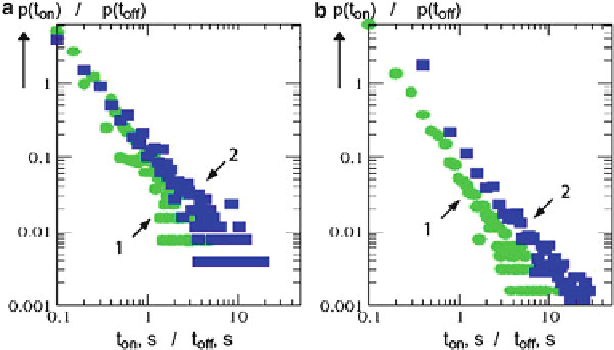Biomedical Engineering Reference
In-Depth Information
Fig. 4.9
Blinking statistics for single TOPO capped CdSe/ZnS QDs (
a
) and for single “QD-QDs
in the presence of (m-Pyr)
4
-H
2
P” at molar ratio
x
10
−
9
=
10 (
b
). QD parameters:
C
QD
=
1.8
×
M,
d
CdSe
=
W. Samples have been
prepared by spin coating from toluene solution onto quartz surface at 295 K. The presented
data were averaged for at least 20 individual objects from free and porphyrin-assembled QDs.
Distributions of on-times (1,
green
) and off-times (2,
blue
) are indicated in each graph. Adapted
from [
75
]
3.2 nm,
n
ZnS
=
3; laser excitation at
λ
=
514.5 nm,
P
=
250
exc
inherent to broadly distributed (de-)population processes of the dark state. In case
of nanoassemblies, values for
t
on
=
0
.
18 s do not change with respect to those
measured for QD (
18 s), while a substantial increase of the “off”-times
is observed for QD in the presence of porphyrin molecules (1.2 s in comparison
with 0.75 s). This elongation of dark periods is equivalent to PL quenching. These
findings are considered as a proof of QD-porphyrin interactions leading to QD PL
quenching also on a single assembly level.
Finally, when numerically analyzing QD PL quenching data for various por-
phyrin molecules in order to evaluate the corresponding complexation constants
K
c
one should take into account few aspects: ligand exchange dynamics (depending on
TOPO concentration and solvent properties) and the number of H
2
P molecules on
the QD surface. Without consideration of the dynamic equilibrium, it is reasonable
to assume that the PL quenching rate for a given QD with
n
attached chromophores
is proportional to
n
, whatever the quenching mechanism is. Like it has been done
earlier [
125
]aswellasinour[
62
] and in recent publications [
23
,
126
], the number of
QD-porphyrin (or, in general, QD-Dye) assemblies may be described by a Poisson
distribution
t
on
=
0
.
x
n
exp
P
(
n
)=
(
−
x
)
/
n
!
,
(4.1)
where
x
is the average number of chromophores per one QD (estimated from a molar
ratio (
x
[H
2
P]/[QD])), n is the number of attached chromophores on a given QD.
Correspondingly, the QD PL intensity ratio
I
(
x
)/
I
0
may be written as [
62
,
101
,
122
]
=

